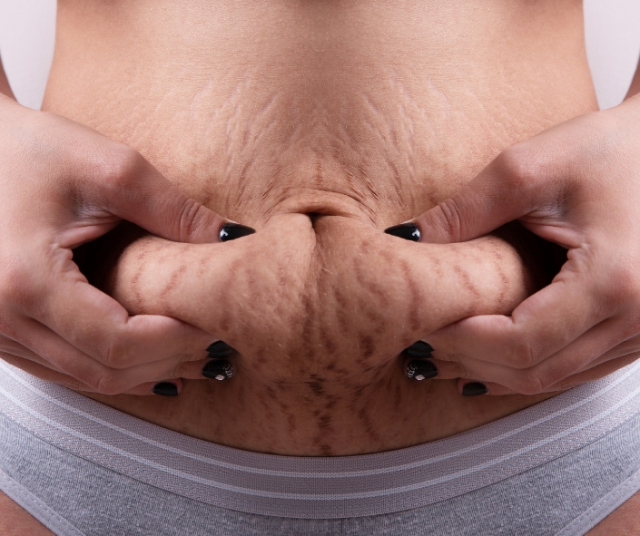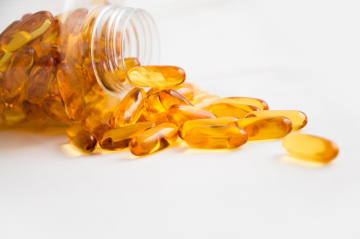Stretch marks are marks on the skin that appear when the skin is stretched rapidly, which can occur during pregnancy, rapid growth in adolescence and, relevantly for this article, during weight loss. Although stretch marks do not represent a serious health problem, they can affect a person's self-confidence and emotional well-being. In this article, we will explore effective strategies to avoid stretch marks while losing weight safely and sustainably. From skin care to diet changes and exercise, we'll look at each aspect to understand how to prevent and minimize the appearance of stretch marks during the weight loss process.
Understanding stretch marks and their relationship with weight loss.
Before we dive into strategies to avoid stretch marks when losing weight, it's important to understand what stretch marks are and how they form. Stretch marks are scars on the skin that develop when the dermis is stretched rapidly and collagen fibers break down. This sudden stretching can occur during periods of rapid growth or weight gain, as well as during weight loss. During weight loss, the skin can lose elasticity and firmness, increasing the risk of developing stretch marks as the body adjusts to its new size and shape.
Strategies to avoid stretch marks when losing weight.
Maintain gradual weight loss.
Gradual weight loss is one of the best ways to avoid stretch marks. Losing weight slowly allows the skin to gradually adapt to changes in body size and shape, reducing the risk of excessive stretching and the formation of stretch marks. A gradual weight loss of around 0.5 to 1 kilogram per week is recommended to minimize the risk of stretch marks and allow the skin to adjust in a healthy way.
Skin hydration.
Keeping your skin well hydrated is crucial to preventing stretch marks. Dry, dehydrated skin is more likely to develop stretch marks when stretched. Regularly apply lotions or moisturizing creams all over your body, especially on areas prone to stretch marks, such as the abdomen, thighs, hips, and breasts. Look for products that contain hydrating ingredients like shea butter, coconut oil, or almond oil.
Massage and exfoliation of the skin.
Massage and exfoliation of the skin can help improve blood circulation, promote cell regeneration, and maintain skin elasticity. Gently massage stretch mark-prone areas using circular motions, and exfoliate the skin once or twice a week to remove dead cells and improve moisture absorption.
Maintain a balanced diet.
A balanced, nutrient-rich diet is important to maintain skin health and prevent stretch marks. Include foods rich in vitamins, minerals, and antioxidants in your diet, such as fruits, vegetables, whole grains, lean proteins, and healthy fats. These nutrients help maintain skin elasticity, promote cell regeneration, and protect against damage caused by free radicals.
Regular exercise.
Regular exercise can help maintain skin health by improving blood circulation and promoting cell regeneration. Incorporate a combination of cardio and strength training exercises into your exercise routine to keep your skin firm and toned during weight loss. Additionally, avoid excessive use of weights and exercises that put excessive stress on the skin, as this can increase the risk of stretch marks.
Avoid tobacco and alcohol.
Tobacco and alcohol can have negative effects on skin health and increase the risk of developing stretch marks. Tobacco reduces blood circulation and oxygenation of the skin, which can affect its elasticity and regeneration capacity. Alcohol, on the other hand, can dehydrate the skin and affect its ability to retain moisture. Avoid tobacco and excessive alcohol consumption to maintain skin health during weight loss.
Use sunscreen.
Prolonged sun exposure can damage the skin and increase the risk of stretch marks. Use sunscreen with a sun protection factor (SPF) of at least 30 every day, even on cloudy days or during winter. Sun protection helps protect the skin against damage caused by the sun's ultraviolet rays, which can weaken the skin's structure and increase the risk of stretch marks.
Consider professional treatments.
If you have existing stretch marks or are concerned about developing stretch marks during weight loss, consider talking to a dermatologist or aesthetic health professional about treatment options. Some professional treatments, such as microdermabrasion, laser therapy, and chemical peels, can help reduce the appearance of stretch marks and improve skin texture.
Myths and realities about preventing stretch marks.
Myths.
Drinking plenty of water prevents stretch marks: Although hydration is important for skin health, there is no scientific evidence to support the idea that drinking plenty of water prevents stretch marks.
Applying specific oils eliminates stretch marks: While some oils can help hydrate the skin and improve its appearance, there is no solid evidence that they can eliminate existing stretch marks.
Avoiding exercise prevents stretch marks: Although intense exercise can increase the risk of stretch marks, regular, moderate exercise can be beneficial for skin health and prevent stretch marks.
Realities.
Genetics plays a role: Genetic predisposition can influence the likelihood of developing stretch marks during weight loss.
Prevention is key: While stretch marks cannot be completely avoided, taking preventative measures can significantly reduce the risk of developing them during weight loss.
Patience is important: Preventing and treating stretch marks can take time and require patience and consistency in skin care.
Preventing stretch marks during weight loss is possible with proper skin care, a balanced diet, regular exercise and healthy lifestyle habits. By taking a comprehensive approach to skin care and overall wellness, you can minimize the risk of developing stretch marks and maintain the health and appearance of your skin throughout your weight loss journey. If you have concerns about stretch marks or need additional guidance, consider speaking with a dermatologist or health care professional for personalized advice and support. Remember that each person is unique and finding the right strategies for you may take time and experimentation. With patience, care, and consistency, you can maintain the health and beauty of your skin while working toward your weight loss goals.






